15 Ecommerce Personalisation Examples To Optimise Customer Experience
This is your one-stop-shop for ecommerce personalisation tactics that will help you improve the customer experience and drive growth amidst rising online competition!
Written By
Catherine Lambert

For a successful ecommerce brand, personalisation should be a top priority.
With so many options available online, customers need to feel an affinity with a brand – to feel understood and valued. Shoppers are increasingly demanding personalised ecommerce experiences tailored to their individual needs – gone are the days of a one-size-fits all approach.
What’s more, personalisation can be a crucial competitive differentiator for your brand. 2020 was a year of exponential growth for ecommerce, with retailers moving online in their droves. In the face of increasing ecommerce competition and the soaring acquisition costs that have come with it, personalisation is pivotal for improving customer experience and ensuring shoppers give their loyalty to you rather than your competitors.
Ultimately, if you haven’t considered personalising your brand experience, you’re missing a very valuable trick.
With that in mind, here are some achievable ecommerce personalisation examples that can see you not only improve your core metrics, but build long term customer loyalty and increase lifetime customer value.
What is personalisation and why is it important in ecommerce?
Let’s begin with the basics. What is personalisation? Ecommerce personalisation means that each individual customer sees content that is tailored towards their own consumer needs or interaction history. This could be specific promotions, product recommendations, email marketing or other content.
Personalisation is often achieved using data drawn from the customer’s location, browser history or account information, such as purchase history, if they are signed in.
The result? Consumers feel increasingly connected to your brand, spend more time on your store and, hopefully, buy more products from your brand. Personalised content can dramatically improve turnover as well as profitability, as customers see products and promotions that are relevant and engaging.
Without personalisation, your store could be missing out on a lot of revenue. The good news is, the return on investment (ROI) of personalisation is excellent. With reduced acquisition costs, higher conversion rates and an overall higher customer lifetime value, personalisation is an area of your marketing that you can rely on to see a good return.
Ecommerce personalisation examples
There are a whole host of possibilities when it comes to personalisation, but that needn’t mean you implement them all. Far better to strategically select the elements that are most likely to deliver the greatest impact on your store.
Below, we’ll explore 15 examples of ecommerce personalisation that other merchants are using to optimise the customer experience and drive online growth.
#1 Homepage personalisation
When a customer lands on your homepage, you want them to feel welcome and reassured that they’ve arrived in a place they’ll find relevant to their needs. Tailoring your visual and promotional homepage content can go a long way towards increasing the appeal of your store, providing an enhanced customer experience right from the outset.
In its crudest form, this means ensuring that a customer has landed on the correct site for their location, so that they find the store in their own language and currency.
But homepage personalisation goes far beyond this.
Greet your customer with a range of personalised links to their favourite categories, recently-viewed items and suggested products. Lay their personalised content out in an easy-to-navigate format, inviting the customer to start their browsing journey with products you know they are likely to enjoy.
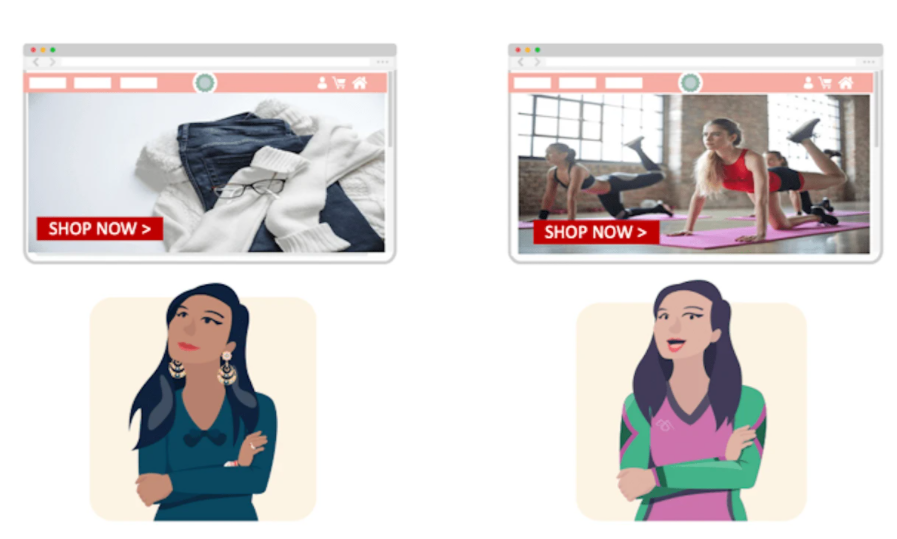
Leverage what you know about your customers to create a tailored point of entry to your ecommerce site. Image source: Shopify
#2 Seasonal content
Seasonality plays an important part in shopping behaviour – particularly for fashion brands. Take advantage of on-site banners and your navigation bar to customise your homepage in accordance with the changing seasons. Highlight winter or summer clothing ranges as appropriate, as well as holiday promotions such as Christmas or Black Friday.
Remember that different countries will experience different climates and celebrate their own annual holidays, so your content needs to reflect that. If it’s summer in Australia, an Aussie customer isn’t going to relate to images of cold, wintery scenes with people wrapped up warm in coats and jumpers – instead, they’ll expect to see sunny scenes captured across your site’s imagery, with recommendations for summer staples like shorts and sandals.
Going beyond seasonality, day-to-day weather can have a particularly powerful influence over shopper behaviour, and a good personalisation agency will be able to fine-tune your site to respond to the current weather in your customer’s location.
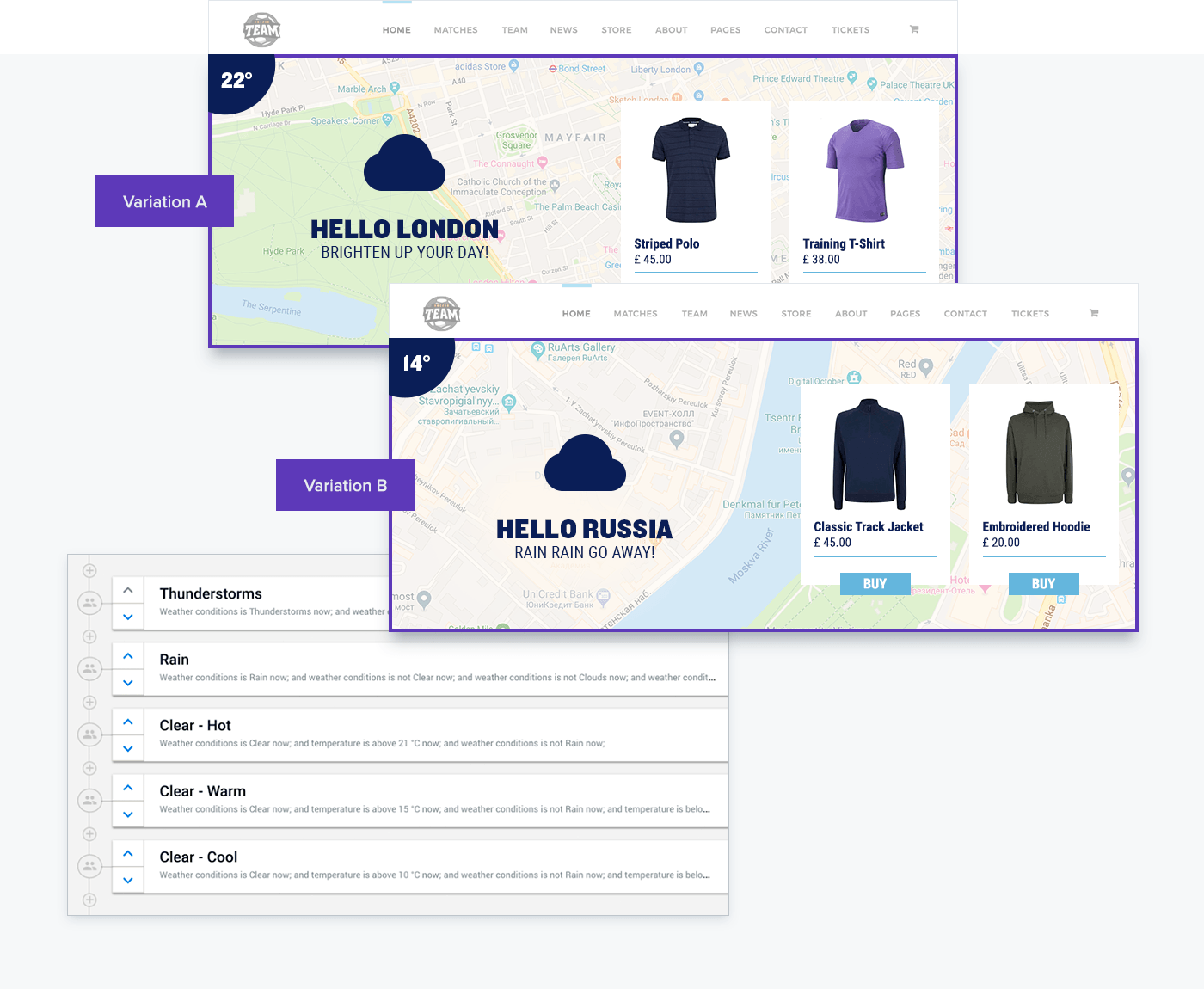
Weather-targeted product recommendations make for a personalised shopping experience that will help set your website apart from the crowd. Image source: Dynamic Yield
#3 Personalised visual content
Personalised imagery is especially important if you’re targeting customers from different cultures. When it comes to cultural norms for instance, some images may be less appropriate in more conservative nations. Thus, try to tailor your visual content to reflect the customer browsing your store, segmenting by geolocation.
If you’re able to, consider segmenting by demographics too, as different genders and age groups can respond differently to image content.
#4 Personalised on-site product recommendations
One of the most common, and most effective, ecommerce personalisation examples is using personalised product recommendations. When you consider the impact that these tailored recommendations can have on key ecommerce metrics, it’s no surprise that this is such a popular personalisation tactic amongst ecommerce retailers. For instance, placing personalised recommendations in emails can increase click-throughs by 557%!
There are various ways to leverage these recommendations across your site. The “You may also like” category – famously introduced by Amazon – was quickly picked up across ecommerce stores as a way to increase order value by promoting related items. However, displaying “visitors who viewed this product also viewed” has been shown to have a far greater effect on sale value.
The chart below shows some of the top performing personalised product recommendations and the percentage of revenue they generate. The popularity of each tactic among merchants doesn’t necessarily correspond to the ROI of each, as you see from the “You may also like” category, so be sure to select ones that have the biggest effect on revenue.
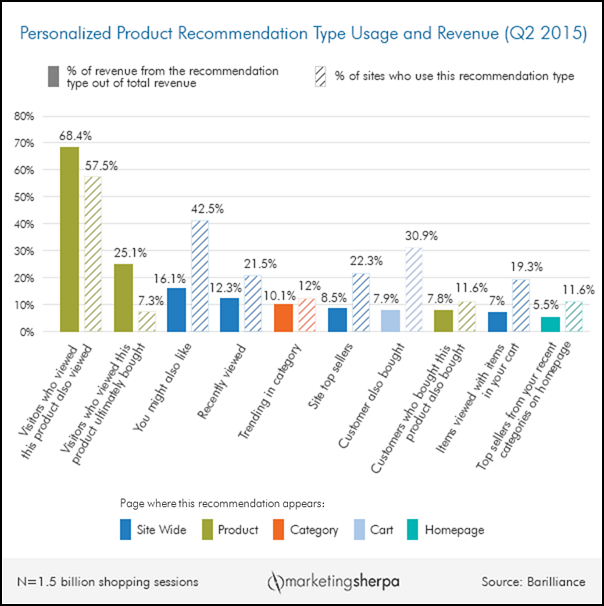
Image source: MarketingSherpa
#5 Personalised search results
As an ecommerce retailer, there’s plenty you can do to make your customer’s search journey smoother and more successful using the power of personalisation.
For returning customers, you can offer auto-suggestions of terms or categories linked to their previous browsing or purchasing history. Offering category suggestions allows them to keep their search broad, whilst focussing on areas that interest them.
You can also tailor the search results page by displaying personalised recommendations based on their current browsing behaviour. And why not try cross-selling and upselling with personalised promotions based on their current search or customer profile?
You can see a great example of multi-level search personalisation over in this guest blog post by Anders Gullander, Head of Product at Findify.
#6 Engage in conversation
Educate your customers as well as getting to know them better by implementing a conversational search element to your website, such as a “virtual personal shopper”. This is set to become increasingly popular throughout 2021, according to Director of Swanky Australia, Sean Clanchy:
“Merchants who lean into things like VIP shopping experiences, video concierge shopping and virtual F2F customer service will stand out from the crowd and differentiate their brands – adding a ‘human element’ for a consumer base who are interaction starved at the moment.”
Rather than relying on the customer to type the right words into a search bar, help them to find what they need by asking them questions to better understand their requirements.
For example, pet supplement subscription company Yumove guide their customers through an interactive questionnaire about their pet to enable the store to offer the most appropriate products, without requiring the customer to already know what they need.
Similarly, nutritional supplement brand Innermost invites users to complete a health quiz so that they can make helpful, personalised recommendations specific to each individual’s needs.
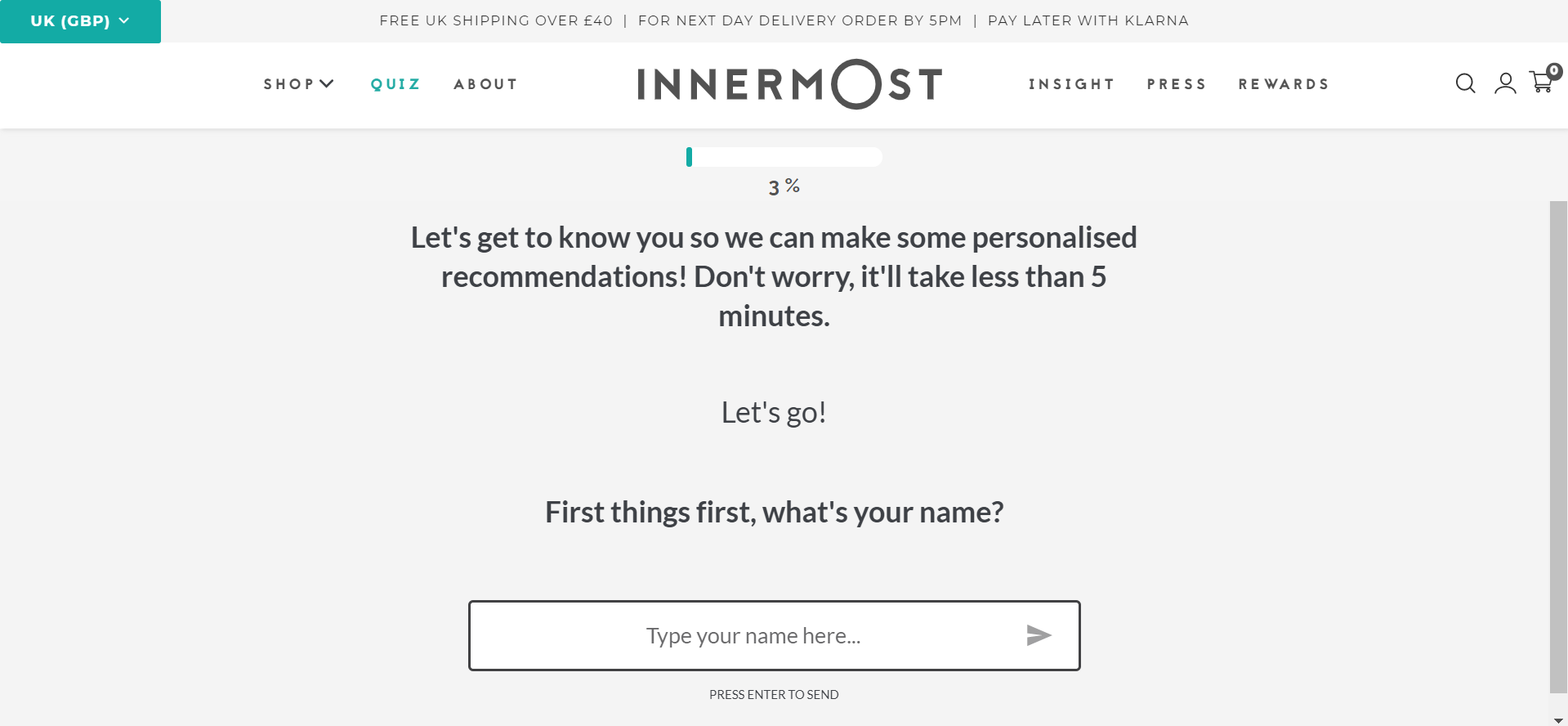
The beginning of Innermost’s health quiz, starting with a simple name capture. Source: Innermost
This process of educating and engaging with customers can build trust and commitment, as well as giving you a wealth of information about your customer to base your personalisation on.
#7 Continuous shopping experience
A customer’s journey may consist of several visits to your site before making the final purchase, so it’s vital that they’re able to continue their shopping experience where they left off. Saving search history and items in their basket means they can make the final purchase with a few clicks of the button, rather than having to start from scratch.
For regular customers, having delivery or payment details saved will make the shopping experience on your site smooth and hassle free, encouraging them to return again and again.
#8 Personalised emails
With the billions of emails being sent every day around the globe, your marketing emails need to stand out from the crowd. Make sure your emails appear relevant and engaging through highly personalised content.
Be sure to include customers’ names in subject lines and email copy – this is the first step to creating a personal connection.
Segment your customers based on their shopping behaviour – frequently visited pages and favourite product type – and include personalised product recommendations and imagery.
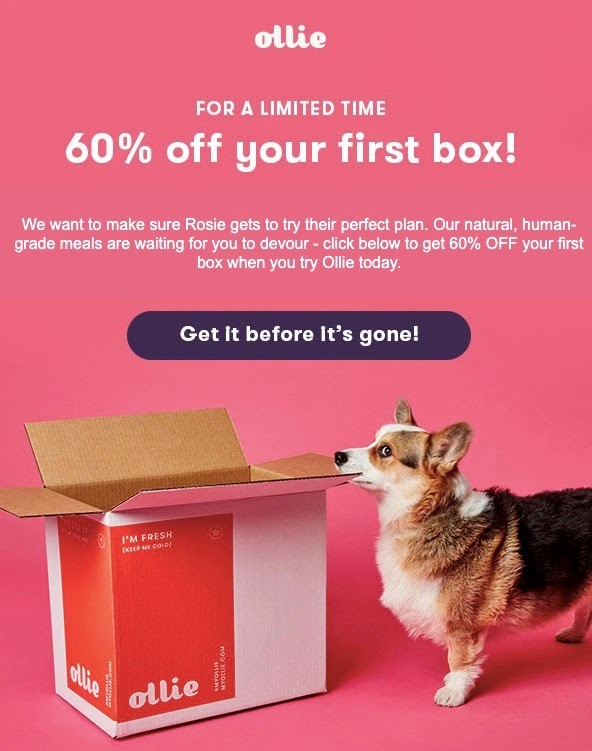
This email includes the name of the customer’s pet pooch – perfect for developing the brand’s relationship with the customer and making them feel valued. Image source: Privy
See our article ‘How to Get Started With Email Personalisation in 5 Steps’ for a step by step guide to personalising your marketing emails.
#9 Personalised calls to action
With a call to action (CTA) such as a newsletter sign up, timing within the purchasing journey is essential. If a customer is at the point of making a purchase, a call to action could be a distraction from a more important goal. However, if they’re at the early research stage of their customer journey, signing up for a newsletter will help to ensure they don’t forget the store when they are ready to make the purchase.
Personalising the content of your newsletter sign up CTA can also achieve a higher conversion rate. Let’s say you present the option to sign up to the newsletter on the post-checkout page. If a customer has just purchased a pair of running trainers, an effective CTA might be “Sign up to our newsletter for tips on staying fit and healthy during lockdown!”.
#10 Personalised delivery and pick-up details
Customers increasingly expect fast delivery options to achieve the instant gratification of holding a new purchase in their hands. Click and collect options have for this reason become popular, placing more emphasis on local stock availability.
Displaying localised delivery times and available pick-up locations will put customers at ease about how soon they can receive or collect their purchase. And by displaying store closing times alongside pick-up options, you can add a sense of urgency to the purchase if they wish to receive it that day.
#11 Abandoned cart retrieval
Although site optimisation goes a long way to reducing abandoned cart rate, another great tactic for winning back sales is through automated abandoned cart emails. It may be that the customer has simply forgotten that they were shopping, so an abandoned cart email can be a helpful reminder, personalised to show the specific abandoned items as well as promoting other relevant items.
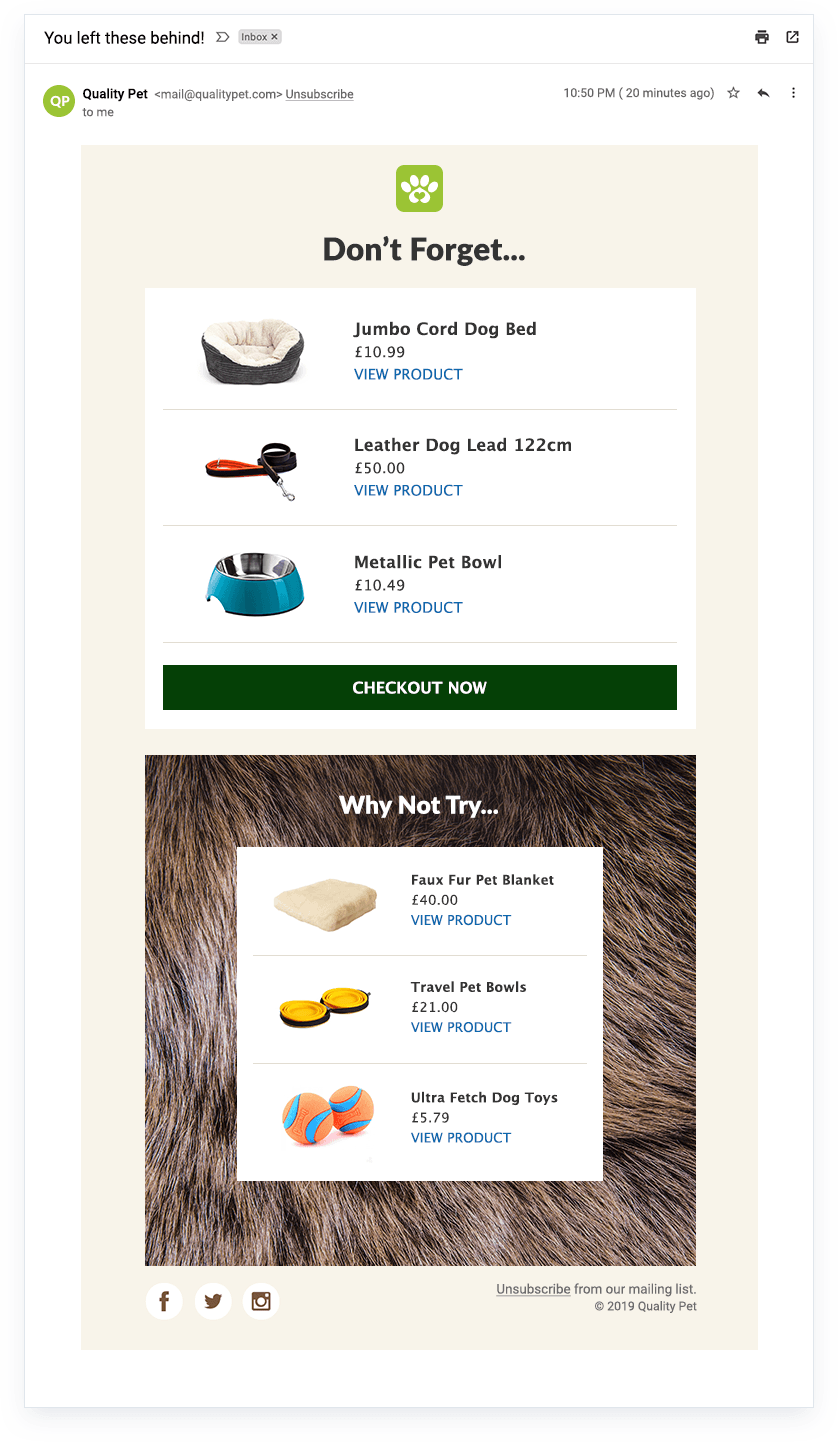
To recapture cart abandoners, this retailer sends targeted reminder emails which include personalised product recommendations. Image source: Dynamic Yield
#12 Personalised post-checkout experience
The shopping experience by no means ends at checkout, and neither do the personalisation possibilities. The post-checkout page gives you a perfect opportunity to engage with your customer further, on a more personal level. You could include:
- A discount voucher for their next purchase.
- Suggested products based on their purchase and information entered at checkout.
- A CTA such as to sign up to a newsletter or follow a social media page.
- An incentive to recommend the site to friends.
#13 Personalised retargeting
Once a customer has purchased from your store, you’ll have a better idea of the sorts of products they’re interested in. You can use this previous shopping behaviour to tailor your retargeting and provide a personalised multichannel experience.
You have various options in terms of content for retargeting. You might choose to show customers their recently viewed items on your store, for instance, or suggested items based on their browsing history. You can also remind people of items they added to their cart but haven’t purchased yet.
If you’re using social media to retarget customers, be sure to customise the timing of messages for greatest effect, depending on when they last visited your store. The value of a customer declines over time, so you should automate your retargeting to optimise its impact.
Despite the value that comes with retargeting, when used unwisely it can annoy potential customers and cost you sales. Amongst the most common pitfalls to avoid are retargeting before someone is ready to buy, serving up the same ad design over and over again, and retargeting post-conversion. All of these things can end up pushing your ads into the hands of ad blockers, so beware!
#14 Personalised pop-ups
Personalising your store’s pop-ups is another helpful tactic for improving the overall customer experience, not to mention boosting the effectiveness of said pop-ups!
Using tools such as Justuno, you can segment your audience and serve personalised pop-ups to each of your customers based on what messages will be most relevant.
As well as the content of your pop-ups, their timing within the customer journey will also have a big impact on their effectiveness. It can make the difference between a pop-up being intrusive or intuitive.
For first-time visitors, you could offer an introductory discount voucher to encourage them to keep shopping. Alternatively, wait till an item has been added to cart before offering a tiered discount to help increase order value – 10% off orders over £25, for example, or free shipping over a certain order value. Finally, you might target people before they leave the site using tailored exit-intent pop-ups to offer a “before you leave” discount offer, enticing them to stay with money off a product they’ve been engaging with.
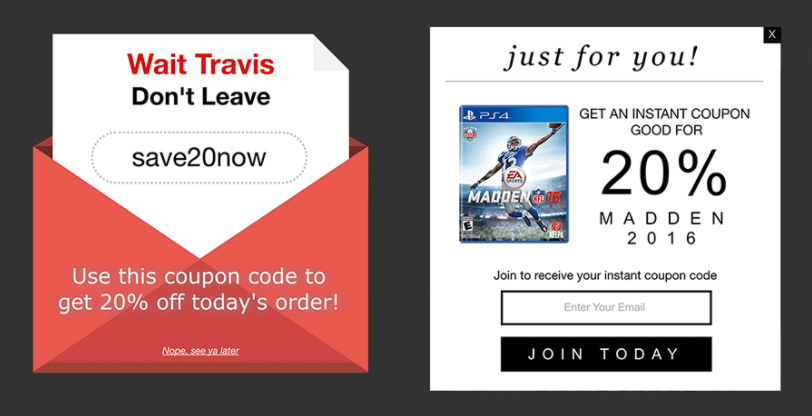
Pop-ups can be personalised to directly address customers by name, or to include messaging about specific products from a customer’s browsing and purchasing behaviour. Image source: Justuno
A word of caution when it comes to pop-ups: when used too frequently, or with irrelevant messaging, pop-ups can become annoying for your website visitors. Always follow best practice advice to ensure your pop-ups don’t detract from the user experience.
#15 Instant live chat and chatbots
Some customers crave a greater level of interaction when making a decision on a purchase – especially an expensive one. Rather than leaving them to trawl through FAQ results to find the answer to their query, offering an instant live chat feature will save them time and make them feel valued. The conversational nature of live chat allows for a personal touch that helps build customer loyalty.
Similar to asking for help from a shop assistant, a live chat function gives customers a chance to ask detailed questions about the product before making their purchasing decision. It also provides an extra opportunity for your agents to persuade them of the virtues of the product, whilst collecting valuable data about their needs and expectations in an unobtrusive manner – perfect for future personalisation efforts.
Chatbots are also becoming increasingly popular amongst ecommerce retailers and shoppers alike, thanks to the innovative way they can build strong relationships with customers on a 24/7 basis.
Although some people argue that chatbots lack the personal touch that live chat offers, developments in artificial intelligence (AI) mean that they can offer personalised product suggestions that are statistically most likely to drive conversions and revenue. This improves the customer experience by making it easier and faster to find relevant products, whilst at the same time feeding your AI engine with further data.
The power of personalisation
Personalisation ensures you stay relevant to your customer, no matter who they are. Instead of bombarding shoppers with products and offers, personalisation enables you to prioritise and optimise all your promotions, selecting the most applicable items for each customer. It maximises the potential of your content marketing and improves the experience of every customer visiting your store. What’s not to love?
Your personalisation agency
Swanky is an experienced personalisation agency with a forward thinking, data-led approach. Using the latest and best technology, we enable you to segment your customers and boost engagement through targeted, personalised content.
If you’re looking for a personalisation agency to unlock the potential of your ecommerce store, we’d love to chat.

